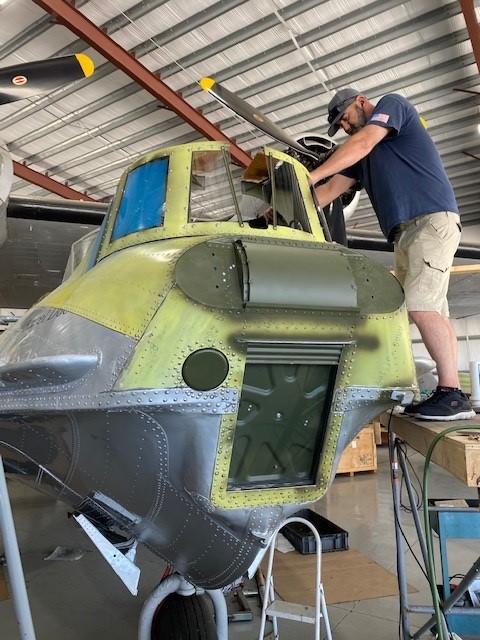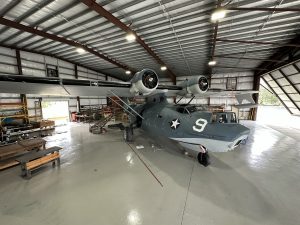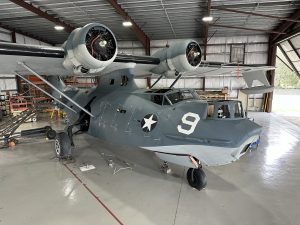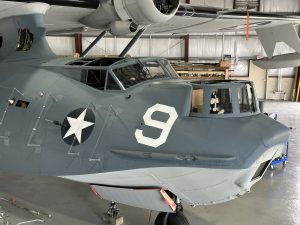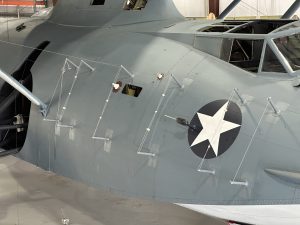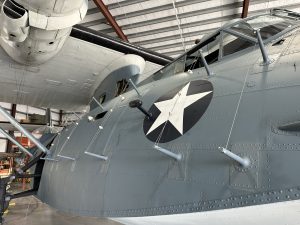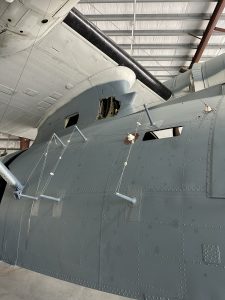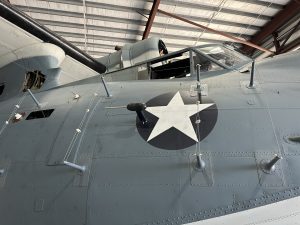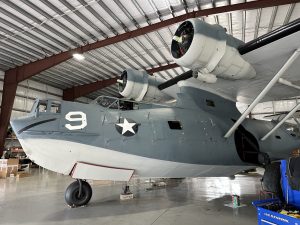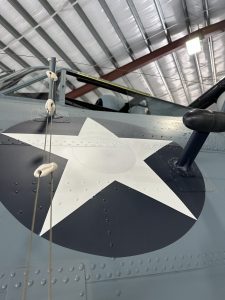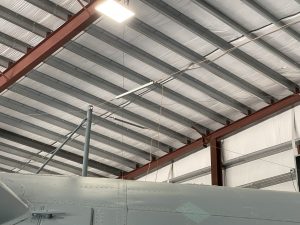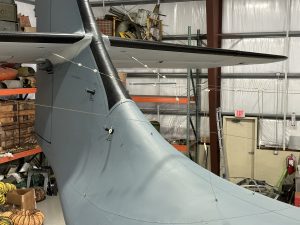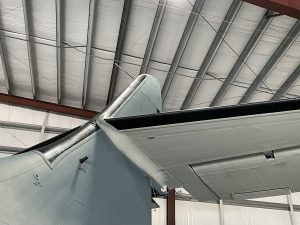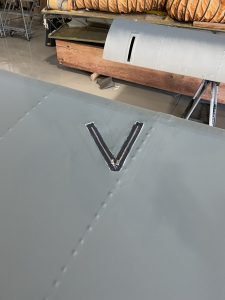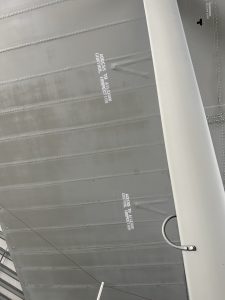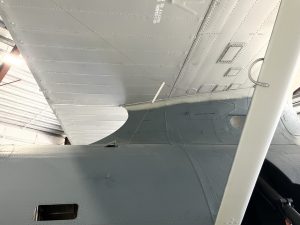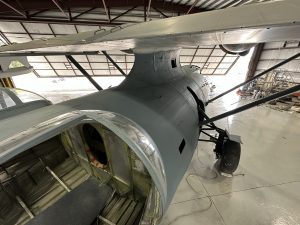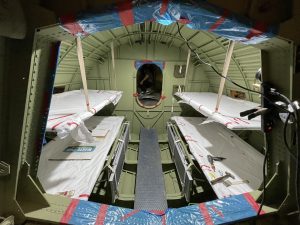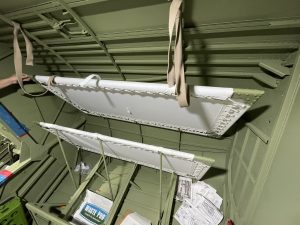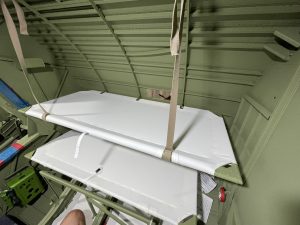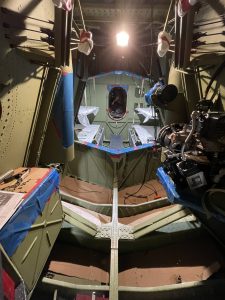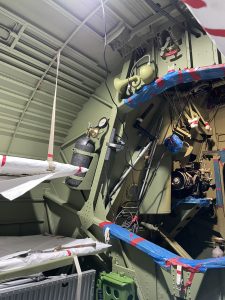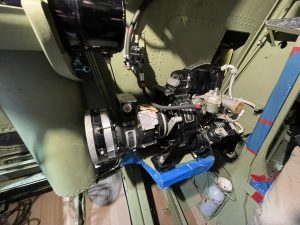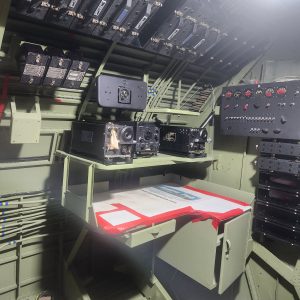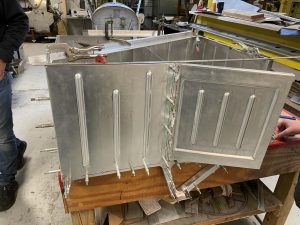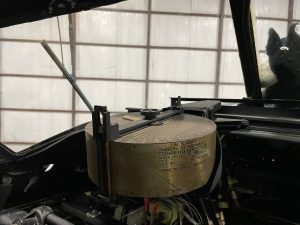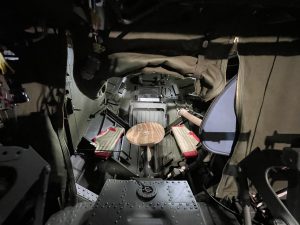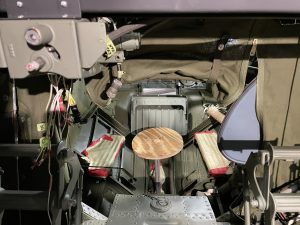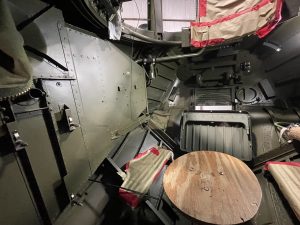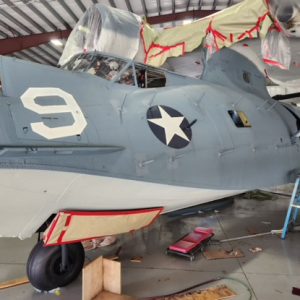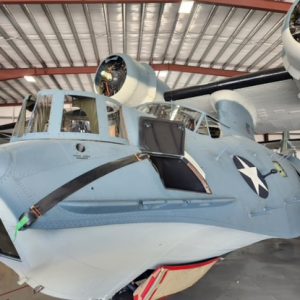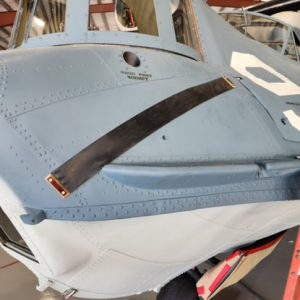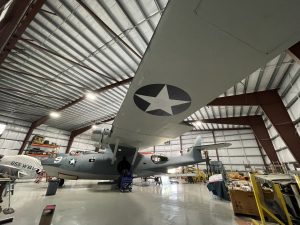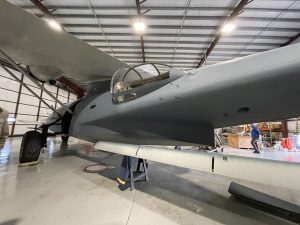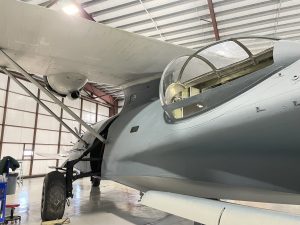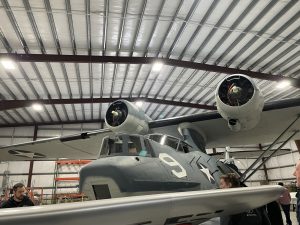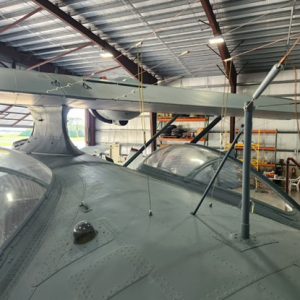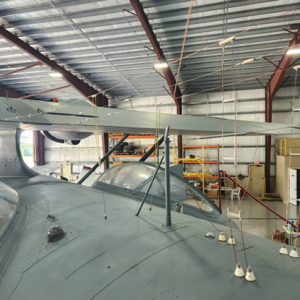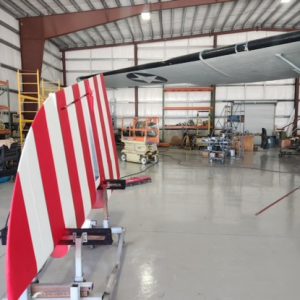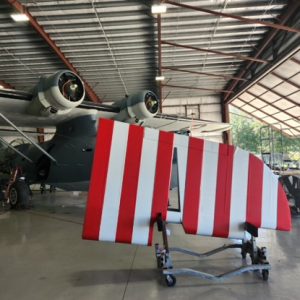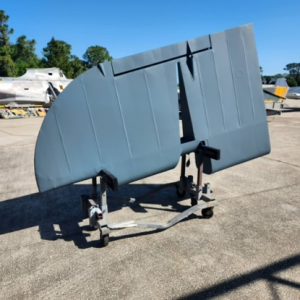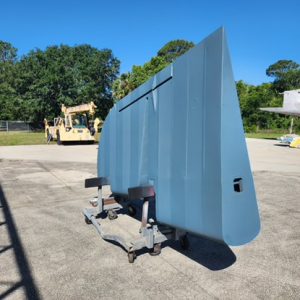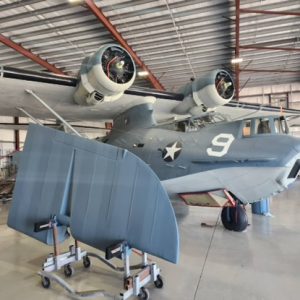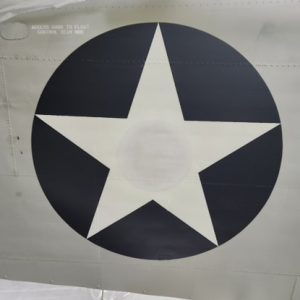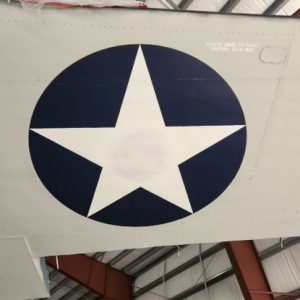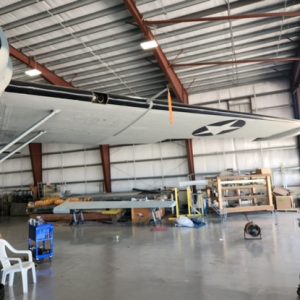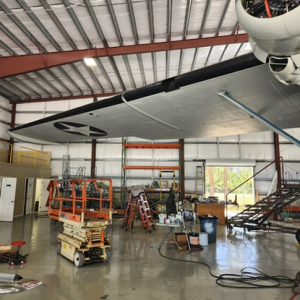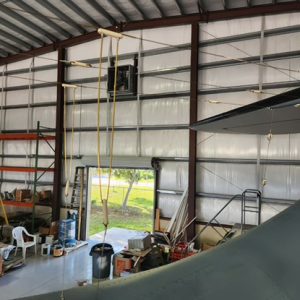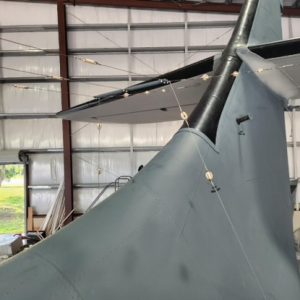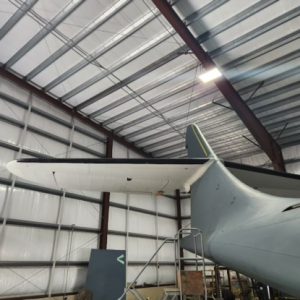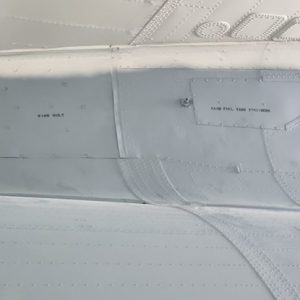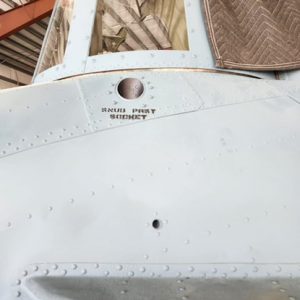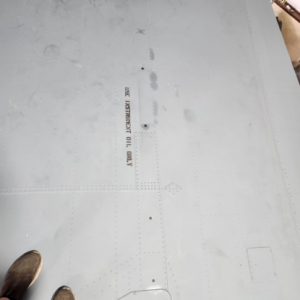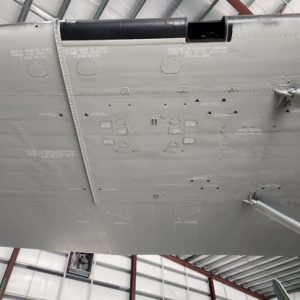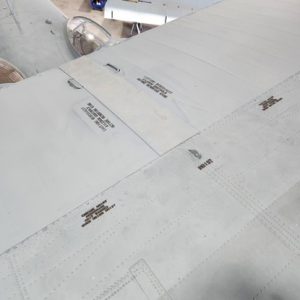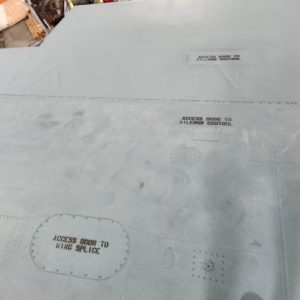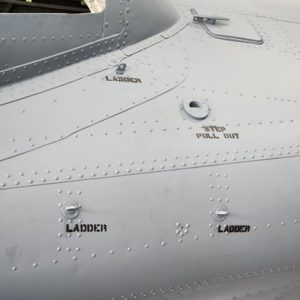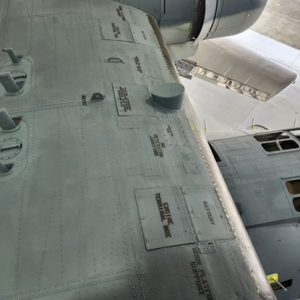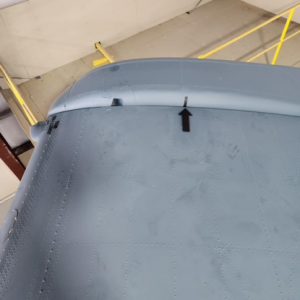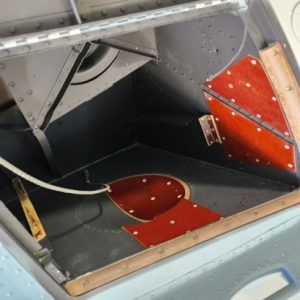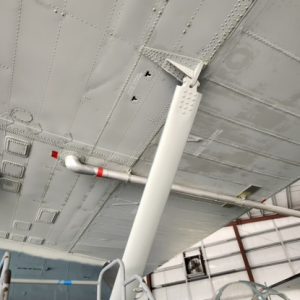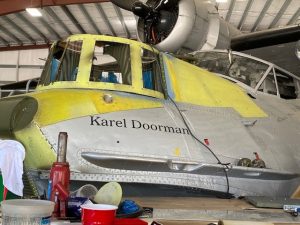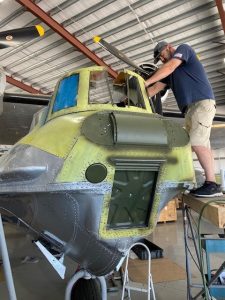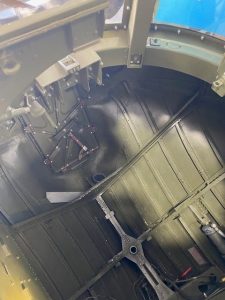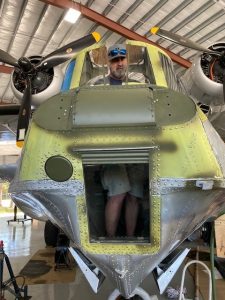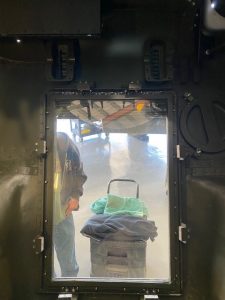The Battle of the Atlantic was the only part of the Second World War that truly worried Winston Churchill. That the Island Nation was under siege was not new, but the effectiveness of the Kriegsmarine’s U-Boat campaign was very clear. The British Isles were being starved by the actions of the U-Boats. The Allies first triumph in the Battle for the Atlantic was modifying the prewar PBY Catalina patrol plane into the ASW, for Anti-Submarine Warfare. The PBY Catalina was capable of excellent endurance (15-20 hours) over the hostile North Atlantic. It began to protect convoys before the advent of aircraft carriers and the evolution of surface ship technology were able to assist them. PBY type aircraft destroyed 38 German U-Boats during the war. Our PBY, Bu. No. 2459, accounted for three destroyed U-Boats and one damaged that never sailed again. It is the USN’s highest scoring U-Boat distroyer aircraft in history and the oldest operational PBY Catalina, having been flown continuously since its construction.
On the production line during the attack on Pearl Harbor, Bu. No. 2459 was one of the first five PBY-5A amphibians built. Due to extremely hazardous sea conditions off Iceland, its group was sent to VP-73 as soon as they rolled off the assembly lines. Accepted by the Navy on December 22, 1941, Bu. No. 2459 was the fourth amphibious PBY built for the United States Navy. It was pressed into action immediately upon arrival. Assigned to VP-73 as aircraft number 9, it was the first PBY to sink a U-Boat.
The ASW detachment in Iceland had been attempting to sink a U-Boat for some time, and the commander of the base, believing that too many late nights at the “O Club” were responsible for the lack of success, had closed the club. On August 20, 1942, Lt. RB Hopgood’s crew in 2459 discovered and sunk U-464. After seeing the sub’s crew rescued by a fishing boat, and an oil slick from the sunken vessel, Lt. Hopgood sent an “in the clear” radio message that would become iconic in the USN’s patrol community: “Sunk sub, open club!”
That history alone makes Bu. 2459 the one to have! But it brought additional good fortune to the Navy. On October 5, 1942, Bu. 2459 was flying the last P-73 convoy mission of its deployment, protecting HX-209. The plane’s crew, headed by Chief Aviation Pilot M. Luke, discovered U-582 on the surface. They sunk this sub as it was organizing a wolfpack attack. The U-Boat, one of 16 deployed against the convoy, went down with all hands. This attack brought VP-73’s score to two sunk, both by Bu. 2459. Its success was exceptional. Only half of VP-73’s allocated PBY aircraft survived their first deployment. Bu. 2459 was the only one of those first 5 PBYs built that flew until the end of the war. Hazardous sea conditions, and even friendly fire, were deadly to the Catalinas.
Notably, a sister PBY, Bu. 2458 is listed as being wrecked on June 20 by friendly fire from a nervous convoy and subsequently destroyed on landing. Rebuilt at a depot, it reentered the fleet assigned to VP-84, in Reykjavik, coded as 84-P-7. Flown by Lt. Joseph Beach on June 24, 1943, it proved it still had the heart of a hunter, spotting U-194 on the surface south of Iceland. After depth charging the sub on the surface, and exchanging gunfire, the combatants fought to a standstill. The Captain of U-194, realizing that the PBY would not give up, attempted to disengage from the Catalina by diving. What was unknown to the sub crew at the time was that PBY Bu. 2458 carried a new and secret weapon – – a “FIDO” acoustic homing torpedo. This technology was a revolutionary development in aircraft based ASW. Although the PBY crew reported the sub as damaged because they did not see it sink, postwar research confirmed that U-194 was destroyed that day in the North Atlantic.
Incidentally, our PBY Bu. 2459 was the second aircraft to sink a submarine using the homing torpedo. This PBY is by far the most significant patrol aircraft, and highest scoring sub killer in history. It still has its original fuselage and wing, remaining intact and airworthy. It is truly one of the most historic aircraft remaining from the Second World War. PBY Bu. 2459 is currently at American Aero Services in Florida undergoing additional restoration with the addition of a nose and waist gun turrets.
*The PBY is currently being restored in Florida and not available for public viewing. Check back regularly for status updates.
Thank You to Our Major Supporters
The restoration of Consolidated PBY-5A Catalina BuNo 2459 would not be possible without major support provided by the dedicated donors listed below. We are extremely grateful for their generosity to help us bring this incredibly historic artifact of United States Naval Aviation back to life.
Anonymous (1)
David Prescott
J. Steven Whisler
The Gerard B. Lambert Foundation
Jennifer and Gary Applebaum
The Hewlett Family Foundation
Restoration Update – March 2025
That old saying “the devil is in the details” certainly holds true for the ongoing restoration of Consolidated PBY-5A Catalina BuNo 2459 in New Smyrna Beach, FL at American Aero Services. Though the exterior restoration is mostly complete, the interior restoration to bring the aircraft back to accurate 1942 wartime configuration has been an enormous task that has tested the skills of the restoration crew led by project manager Casey Littrell. Because the aircraft arrived from Europe with little original equipment, nearly all of the interior components have either had be found or fabricated. And considering the early vintage of this PBY, original equipment is scarce… so just sourcing the materials is a monumental task in its own right. And for items that need to be fabricated, finding original drawings or photos to accurately reconstruct items is an additional challenge.
As you look through the gallery below, here is a brief description of the items highlighted for this update.
External photos of the PBY highlight the completed antenna array of the early variant of ASV (Air-Surface Vessel) radar found on this PBY-5A during its deployment to Iceland in 1942. Looking more like clothes lines than modern radar, this early deployment of airborne radar was the foundation of rapidly improving technology that evolved through the war. It is fair to say that no other PBY (or currently surviving warplane from WWII for that matter) has never had such an extensive antenna array installed for historical accuracy.
When the PBY arrived at American Aero Services in 2019, the interior had been modernized with seats and additional comforts for passenger flights. But as most of it was not correct for wartime configuration, it was stripped and the team started to rebuild the interior from scratch. As wartime PBYs were commonly flew 10-15 hour missions, there were some spartan accommodations provided for crews to make such missions possible… one being a bunk room. As of this month, the mid-ship bunk area has been mostly completed and now only smaller equipment details are being installed to complete this area.
Moving forward through the aircraft, the Flight Engineers position in the central wing pylon has been installed and only needs a few small details to complete. This unique crew position allowed had the Flight Engineer (FE) seated high over the central compartment with a window on each side of the pylon to monitor engine health through the flight. The FE had a dedicated engine instrument panel and could adjust power settings independently of the pilots if needed.
Just behind the cockpit area is the radio operators station. In the maritime patrol role, this crewmember was vital for not only communications but also monitoring any potential enemy transmissions. The early radio transmitter and receiver units and radar units have been a great challenge to find and restore for the team. The custom fabrication of the mounts and shelves for the units for installation is ongoing, but the photos of the mostly completed station with details like the restored spare equipment box is a testament to the American Aero Services team and their attention to detail.
In the cockpit, a very unique instrument has been installed… the Mark 28 Torpedo Director. This detachable instrument was an analog computing device to allow the pilot to target an enemy vessel and compensate for movement and speed. In looking at the engraving on the side of the unit, there is a great local connection with the instrument being originally manufactured by Lundquist Tool & Mfg. Co. of Worcester, MA.
And finally, at the very front of the aircraft is the completed bombardier and nose turret compartment. This area was completely rebuilt as the PBY arrived in 2019 with this entire area removed and a streamlined “clipper” nose installed in place of the turret. All that is left is the installation of the removable equipment and supplies that would have been found in this compartment.
Stay tuned for another update in the early Summer!
Restoration Update – May 2023
The restoration of Catalina BuNo 2459 continues to move closer to completion at American Aero Services in New Smyrna Beach, FL. Now that all the fabrication of the original turrets has been completed, the focus has shifted to the exterior completion of the aircraft including a repaint to accurately represent what it would have looked like in Summer of 1942. The flat two-tone blue and white paint has been applied along with most of the markings. One unique detail is where our restoration staff painted the markings it would have worn when brought out of the factory, including the red and white striped rudder and the U.S. Navy star, including the red circle within it. Just as what would have been done when it was taken into service, our staff repainted over these colorful markings with the flat blue, leaving the faintest trace of the stripes on the tail, and painted out the red “meatball” in the star with flat white… an accurate detail that makes a huge difference in authenticity! Our team is also meticulously adding all the painted nomenclature stencils as would have been seen in 1942 as well.
Another major effort is the installation of the early variant of ASV (Air-Surface Vessel) radar used on the long range patrol PBYs in the Atlantic, which is the network of wires and standoffs you see in the photos below. These systems are rarely seen on restored aircraft due to their scarcity, so we are fortunate to have been able to source most of it.
Once the exterior is complete, the team will focus on re-installation of original equipment inside the aircraft and detailing it to wartime service configuration this summer. Stay tuned for that update!
Restoration Update – April 2021
Restoration work continues at American Aero Services in New Smyrna Beach, FL to bring our very historic Consolidated PBY-5A Catalina, Bu. No. 2459 back to wartime configuration. When completed, this plane will look exactly as it did when flying with VP-43 based in Iceland from 1942 to 1944. This amphibious reconnaissance and bomber airplane protected vulnerable shipping convoys from the deadly German U-Boat menace and was one of the first aircraft to fight in the Battle of the Atlantic. If you saw the Tom Hanks movie “Greyhound” from Summer 2020, you know how dire their situation was. This very PBY-5A is credited with 3.5 U-Boat “kills” to its record, making it not only the oldest PBY flying, but also the most historically significant.
Once the aircraft was brought back to the United States from the Netherlands in the Summer of 2019, the process to transform it back to stock condition began. Arguably the most complex conversion was to remove the smooth, civilian “clipper” nose modification and reinstall the original gun position and bomb aiming window along with all the associated instrumentation, drive mechanisms, and window “hatch” and curtain to protect this area during water landings.
Though the gun position looks like a turret, the rounded glass area is nothing more than a rotating .30 cal machine gun mount. The gun would need to be mounted when used and the enclosure offered little comfort for the gunner against the cold slipstream of the North Atlantic. The top of the gunner’s head was exposed by the opening in front of the aircraft! Later variants of the nose position in PBY-6A models converted the gun to a dual .30 cal with a manufactured “bubble” to enclose the gunner.
As you can see from the photos, the complexity of the sheet metal fabrication for this area is very difficult with many compound curves and internal supports. Thankfully, sheet metal expert Casey Littrell at American Aero Services had the skills needed to accomplish this task! Additionally, many other large components like the corrugated curtain and internal hatch had to be painstakingly re-fabricated from original factory drawings.
As you can see in the photos to the left, the bomb sight aiming window is sandwiched between a watertight door (far left) and the corrugated shield (immediate left) that protected the glass from icing and salt spray. The simple but effective addition of this shield was a hard learned experience for the Navy as they operated in the harsh environment of the North Atlantic.
Once this section is complete, American Aero Services will move on to the restoration of the waist blister gun emplacements with original equipment, before stripping the existing paint and repainting this historic aircraft back to its original VP-43 scheme.






